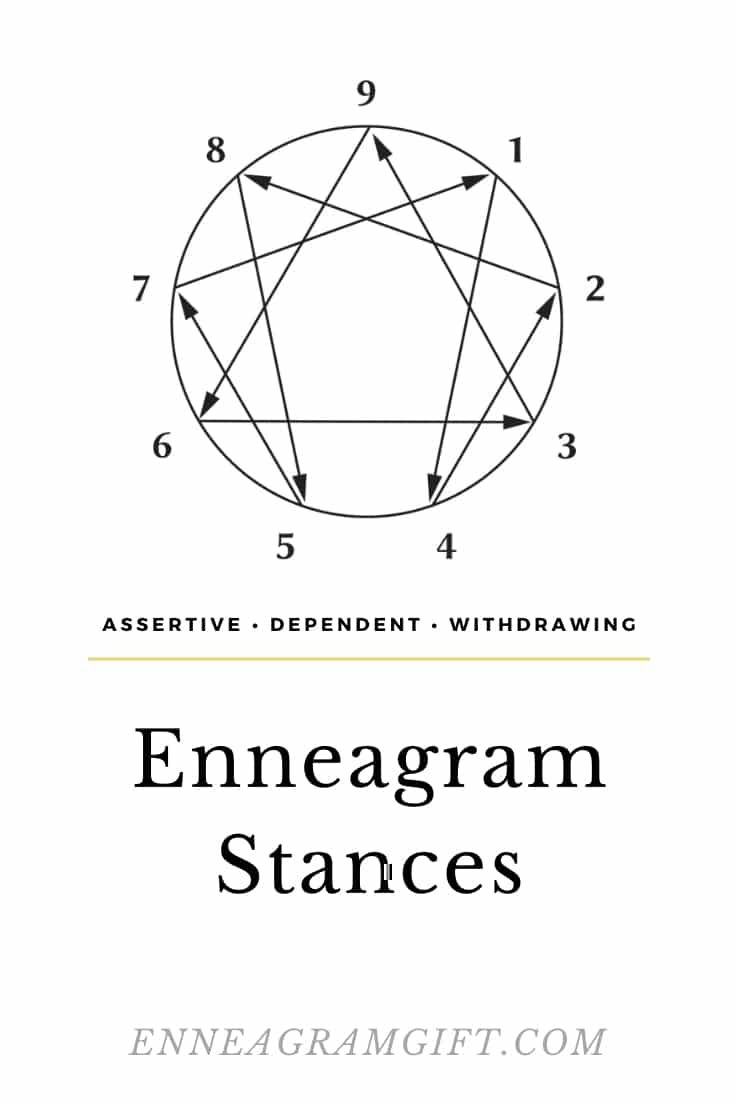At the heart of the Enneagram is the concept that each of the nine types has distinct pathways for coping with stress and achieving growth. These pathways are often visualized as lines connecting the types on the Enneagram symbol, indicating the direction of change during periods of stress (disintegration) and growth (integration).
Stress and Disintegration: Under stress, each Enneagram type tends to adopt some characteristics of a different type, often revealing behaviors and attitudes that are less healthy or adaptive. This shift can be a signal to us that we need to pay attention to our coping mechanisms and underlying anxieties.
Growth and Integration: Conversely, in times of growth or when we are moving towards our higher selves, we exhibit qualities of another Enneagram type, but in a more positive and constructive manner. This integration suggests a harmonious alignment with our core values and an enhanced capacity for emotional resilience.
Understanding the Lines of the Enneagram System
The Enneagram symbol is not just a collection of numbers; it’s a dynamic map of interconnected paths that reveal how different types react under varying circumstances. Central to this are the ‘lines’ that connect each type to two others, indicating the directions of stress and growth.
The Lines of Movement:
- Stress Line: This line shows the type a person gravitates towards under stress, often adopting some of that type’s less healthy characteristics. It’s a natural, albeit subconscious, response to challenging situations.
- Growth Line: Conversely, the growth line points to the type a person moves towards in times of security and personal development. Here, an individual exhibits the healthier traits of that type, reflecting personal growth and maturity.
How to Interpret the Lines:
- Identify Your Type: First, know your primary Enneagram type.
- Trace the Lines: Look at the Enneagram symbol and notice the lines connected to your type.
- Understand the Direction: One line leads to your stress point, and the other to your growth point. For example, Type 1 connects to Type 4 in stress and Type 7 in growth.
If you’re already familiar with your Enneagram type, understanding these stress and growth paths can offer valuable insights into your behavioral patterns and emotional responses. For those still exploring their type, observing these patterns can be a helpful step in the identification process. Here’s how you can use this knowledge:
- Recognize Stress Patterns: By being aware of the characteristics your type exhibits under stress, you can develop strategies to manage stress more effectively and maintain emotional balance.
- Embrace Growth Opportunities: Understanding your path to integration can guide you in nurturing the positive traits associated with your growth type, leading to personal and spiritual development.
- Broaden Your Perspective: Learning about the interconnectedness of different Enneagram types enhances empathy and understanding, both for yourself and others.
Remember, the Enneagram is not just about labeling or categorizing personalities; it’s a dynamic tool for self-awareness and transformation. By exploring the intricate connections between stress and growth within the Enneagram framework, you embark on a journey towards a more authentic and fulfilling life.
The Dynamics of The Enneagram Stress and Growth Lines For Each Type
Enneagram 1 Stress And Growth
Commonly known as the Perfectionist or the Improver, Enneagram Type Ones are driven by a desire to improve the world around them. They possess a deep-seated sense of responsibility and integrity but can also struggle with underlying anger.

Image Credit: Enneagram Institute
Enneagram 1 in Stress: Moving Towards Type 4 Characteristics
-
Indicators of Stress:
- Increasing self-criticism and harsh judgment towards others.
- Growing resentment towards people perceived as irresponsible or undisciplined.
- Heightened sensitivity to criticism, feeling easily hurt or offended.
- Emotional mood swings, feeling melancholic or withdrawn.
-
Scenario: Imagine a Type One, Alex, who is usually disciplined and controlled. Under stress, Alex starts to feel overwhelmed by a sense of inadequacy and becomes overly critical of colleagues for not meeting high standards. This leads to a sense of isolation and emotional turmoil.
-
Practical Tip: Recognize when criticism is more about internal standards than others’ actions. Practice self-compassion and remind yourself that it’s okay to not be perfect.
-
Additional Insight: Under stress, Type Ones can benefit from embracing the creative and introspective qualities of Type Four, channeling their critical energy into self-expression rather than self-judgment.
Enneagram 1 in Growth: Embracing Type 7 Qualities
-
Indicators of Growth:
- Increased spontaneity and willingness to try new experiences.
- A more relaxed and optimistic outlook on life.
- Embracing joy and pleasure without guilt or self-restraint.
- Demonstrating more flexibility and open-mindedness.
-
Scenario: When experiencing growth, a Type One, Sarah, starts to let go of rigid self-imposed rules. She decides to join friends on an impromptu weekend trip, enjoying the adventure without worrying about the ‘shoulds’ and ‘musts’.
-
Practical Tip: Actively seek out experiences that are joyful and spontaneous. Allow yourself to step out of your comfort zone and embrace the unknown.
-
Additional Insight: Growth for Type Ones involves integrating the joyful, adventurous spirit of Type Seven, balancing their innate sense of duty with a newfound appreciation for life’s pleasures.
Enneagram 2 Stress And Growth
Known as the Helpers, Enneagram Type Twos are driven by a desire to be loved and appreciated. They are inherently warm and caring, often putting others’ needs before their own. Their challenge often lies in dealing with underlying issues of pride and self-neglect.

Image Credit: Enneagram Institute
Enneagram 2 in Stress: Adopting Type 8 Characteristics
-
Indicators of Stress:
- Becoming more assertive, confrontational, and controlling.
- A tendency to manipulate situations or people to meet their needs.
- Shifting blame to others and struggling to acknowledge personal faults.
- Recalling past grievances and using them in arguments.
-
Scenario: Under stress, a Type Two, Jordan, starts to feel unappreciated at work. This leads to a shift in behavior, becoming more demanding and critical towards colleagues, and blaming them for not recognizing his efforts.
-
Practical Tip: Recognize when feelings of being unappreciated lead to controlling behavior. Practice open communication and assertiveness without aggression.
-
Additional Insight: Stressful periods can push Type Twos towards the more domineering traits of Type Eight, but recognizing this shift can help them find a balance between their needs and those of others.
Enneagram 2 in Growth: Embracing Type 4 Qualities
-
Indicators of Growth:
- Acknowledging and prioritizing their own needs and emotions.
- Embracing authenticity and self-expression without fear of being selfish.
- Developing a deeper understanding of their own identity, separate from their relationships.
- Allowing themselves to experience and express a range of emotions.
-
Scenario: In a period of growth, a Type Two, Emma, starts to focus on her own needs. She begins a journaling practice to explore her emotions and desires, learning to say ‘no’ to others when necessary and prioritizing self-care.
-
Practical Tip: Engage in activities that foster self-reflection and self-discovery. Remember that self-care is not selfish, but essential for well-being.
-
Additional Insight: Growth for Type Twos involves integrating the introspective and authentic qualities of Type Four, helping them to balance their innate desire to help others with their own emotional needs.

Enneagram 3 Stress And Growth
Type Threes, known as the Achievers, are driven by a desire for success and recognition. They are goal-oriented and in less healthy states, equate their self-worth with their achievements. However, their focus on success can sometimes lead to issues of deceit and a loss of authentic self.
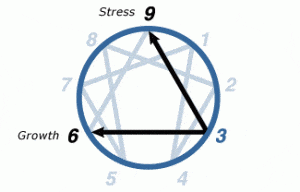
Image Credit: Enneagram Institute
Enneagram 3 in Stress: Adopting Type 9 Characteristics
-
Indicators of Stress:
- A noticeable drop in energy and motivation.
- Engaging in busywork rather than productive tasks.
- Avoiding conflicts and seeking peace at any cost.
- Losing sight of personal goals in favor of complacency.
-
Scenario: Under stress, a Type Three, Alex, starts to feel overwhelmed by the pressure to succeed. Instead of tackling important projects, Alex gets caught up in unimportant tasks, avoiding challenges and conflicts.
-
Practical Tip: Recognize when the pursuit of success leads to burnout. Prioritize tasks and allow time for rest and reflection.
-
Additional Insight: Stress can cause Type Threes to adopt the more complacent and conflict-avoidant traits of Type Nine, but recognizing this shift can help them refocus on their goals and authentic desires.
Enneagram 3 in Growth: Embracing Type 6 Qualities
-
Indicators of Growth:
- Developing a stronger connection with their emotions and values.
- Focusing on building genuine relationships and community.
- Acting in the interest of the group, not just personal gain.
- Embracing loyalty and commitment in their personal and professional life.
-
Scenario: In a period of growth, a Type Three, Mia, starts to value deeper connections over achievements. Mia volunteers for a community project, focusing on teamwork and collective success rather than individual accolades.
-
Practical Tip: Engage in activities that foster community and teamwork. Reflect on personal values and how they align with actions.
-
Additional Insight: Growth for Type Threes involves integrating the loyal and community-focused qualities of Type Six, helping them to balance their ambition with a sense of belonging and emotional authenticity.
Enneagram 4 Stress And Growth
Fours, known as the Creative Individualists, are driven by a desire to be unique and authentically understood. They are deeply in touch with their emotions, often expressing themselves through creativity. However, their intensity of feelings can sometimes lead to moodiness and envy.

Image Credit: Enneagram Institute
Enneagram 4 in Stress: Adopting Type 2 Characteristics
-
Indicators of Stress:
- Increasing dependency on others for validation and support.
- Suppressing their own needs in favor of seeking attention.
- Experiencing heightened sensitivity and a need for reassurance.
-
Scenario: In a stressful situation, Jordan, a Type Four, starts to overly rely on their partner for emotional support, neglecting their own needs and desires in the process.
-
Practical Tip: Recognize the tendency to seek validation from others. Practice self-reliance and affirm your own worth independently.
-
Additional Insight: Under stress, Fours may exhibit the people-pleasing and dependent traits of Type Two, often seeking external validation to feel valued.
Enneagram 4 in Growth: Embracing Type 1 Qualities
-
Indicators of Growth:
- Developing discipline and structure in pursuing creative projects.
- Staying grounded and present, focusing on realistic goals.
- Gaining control over their emotions, avoiding impulsive reactions.
-
Scenario: During a period of personal growth, Taylor, a Type Four, channels their creativity into a structured project, maintaining focus and discipline to bring their vision to life.
-
Practical Tip: Implement routines and structures to help channel your creativity effectively. Focus on being present and grounded.
-
Additional Insight: Growth for Type Fours involves integrating the disciplined and principled qualities of Type One, helping them to actualize their creative potential while staying emotionally balanced.
Enneagram 5 Stress And Growth
Fives, known as the Observers, are characterized by their intense desire to acquire knowledge and maintain independence. They often conserve energy and resources, striving for self-sufficiency. However, their quest for autonomy can sometimes lead to a sense of isolation and avarice.
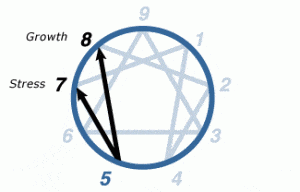
Image Credit: Enneagram Institute
Enneagram 5 in Stress: Adopting Type 7 Characteristics
-
Indicators of Stress:
- Becoming increasingly scattered and disorganized.
- Exhibiting a tendency to avoid issues by seeking distractions.
- Showing signs of condescension and self-centeredness.
-
Scenario: In a stressful phase, Eva, a Type Five, starts to avoid confronting their problems by indulging in various distractions, leading to disorganization and a lack of focus.
-
Practical Tip: Recognize the urge to escape into distractions. Practice mindfulness and confront issues head-on to maintain clarity and focus.
-
Additional Insight: Under stress, Fives may display the restless and escapist traits of Type Seven, often seeking safety in intellectual pursuits and distractions.
Enneagram 5 in Growth: Embracing Type 8 Qualities
-
Indicators of Growth:
- Taking initiative in making positive changes in their environment.
- Supporting others’ efforts and engaging more actively in relationships.
- Exhibiting confidence and decisiveness in their actions.
-
Scenario: During a period of growth, Sam, a Type Five, steps up to lead a community project, confidently making decisions and encouraging team collaboration.
-
Practical Tip: Channel your knowledge into actionable steps that benefit others. Engage in community or group activities to foster connection and assertiveness.
-
Additional Insight: Growth for Type Fives involves integrating the assertive and leadership qualities of Type Eight, enabling them to apply their knowledge practically and engage more fully with the world around them.

Enneagram 6 Stress And Growth
Sixes, known as the Loyalists, are recognized for their commitment, practicality, and wit. They seek security and often struggle with trust issues, leading to anxiety and a reliance on authority figures.
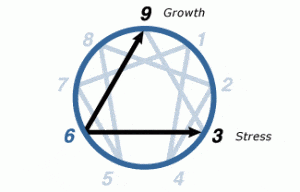
Image Credit: Enneagram Institute
Enneagram 6 in Stress: Adopting Type 3 Characteristics
-
Indicators of Stress:
- Projecting an image of competence and control to the world.
- Becoming overly focused on work and achievements.
- Hesitation to try new things due to fear of failure.
-
Scenario: In a stressful situation, Sara, a Type Six, starts overworking to maintain an image of success, avoiding new challenges due to fear of not excelling.
-
Practical Tip: Recognize the tendency to overwork as a coping mechanism. Embrace new experiences, understanding that growth often comes from stepping out of your comfort zone.
-
Additional Insight: Under stress, Sixes may exhibit the achievement-oriented and image-conscious traits of Type Three, focusing on success as a means of security.
Enneagram 6 in Growth: Embracing Type 9 Qualities
-
Indicators of Growth:
- Developing a more relaxed and easy-going attitude.
- Trusting in their own judgment rather than seeking external validation.
- Viewing life from diverse perspectives and embracing a sense of calm.
-
Scenario: During a period of growth, Mia, a Type Six, starts to trust her instincts more, becoming less reliant on others for guidance and enjoying a newfound sense of peace.
-
Practical Tip: Cultivate self-trust and practice mindfulness to reduce reliance on external authorities. Embrace a balanced perspective to foster inner peace.
-
Additional Insight: Growth for Type Sixes involves integrating the peace-loving and accepting qualities of Type Nine, allowing them to trust themselves and approach life with a more relaxed and open mindset.
Enneagram 7 Stress And Growth
Type Sevens, known as the Enthusiastic Visionaries, are driven by a desire to avoid pain and seek pleasure. They are adventurous, spontaneous, and constantly in pursuit of new experiences. However, their fear of negativity and pain can lead to dissatisfaction and restlessness.
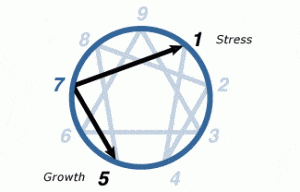
Image Credit: Enneagram Institute
Enneagram 7 in Stress: Adopting Type 1 Characteristics
-
Indicators of Stress:
- Shifting from an optimistic to a pessimistic view of life.
- Becoming critical and argumentative, often blaming others.
- Losing their natural enthusiasm and spontaneity.
-
Scenario: In a stressful phase, Alecia, a Type Seven, starts seeing things in black and white, becoming critical of others and losing their usual zest for life.
-
Practical Tip: Recognize the shift towards negativity and practice mindfulness to maintain a balanced perspective. Engage in activities that foster positivity and joy.
-
Additional Insight: Under stress, Sevens may exhibit the critical and perfectionist traits of Type One, losing their characteristic optimism and becoming more judgmental.
Enneagram 7 in Growth: Embracing Type 5 Qualities
-
Indicators of Growth:
- Developing a deeper understanding and appreciation for solitude.
- Engaging in introspection and seeking deeper meaning in experiences.
- Moving from surface-level pleasures to more substantial and fulfilling pursuits.
-
Scenario: As they grow, Emma, a Type Seven, finds joy in solitude and introspection, exploring her inner world and finding deeper meaning in her experiences.
-
Practical Tip: Encourage periods of solitude and reflection. Explore hobbies or activities that require deeper thought and concentration.
-
Additional Insight: In growth, Sevens integrate the introspective and analytical qualities of Type Five, allowing them to experience life more profoundly and find satisfaction in quieter, more meaningful pursuits.
Enneagram 8 Stress And Growth
Type Eights, known as the Challengers, are driven by a strong desire to assert their strength and avoid vulnerability. They are direct, assertive, and often take charge in situations. Their fear of appearing weak can sometimes lead to a lust for power and control.
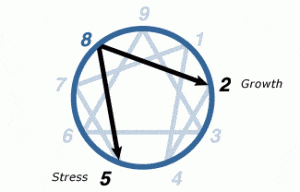
Image Credit: Enneagram Institute
Enneagram 8 in Stress: Adopting Type 5 Characteristics
-
Indicators of Stress:
- Withdrawing emotionally and becoming secretive.
- Neglecting self-care and becoming more isolated.
- Exhibiting a reluctance to share thoughts or feelings with others.
-
Scenario: In a stressful phase, Luka, a Type Eight, starts withdrawing from close relationships, becoming secretive and less emotionally available.
-
Practical Tip: Recognize the tendency to withdraw and consciously engage in open communication. Prioritize self-care and maintain connections with trusted individuals.
-
Additional Insight: Under stress, Eights may display the withdrawn and secretive traits of Type Five, distancing themselves emotionally and becoming more introspective.
Enneagram 8 in Growth: Embracing Type 2 Qualities
-
Indicators of Growth:
- Showing vulnerability and openness in relationships.
- Trusting others and allowing themselves to receive care and support.
- Moving from a stance of control to one of collaboration and empathy.
-
Scenario: As they grow, Susan, a Type Eight, learns to trust and show her emotions, allowing herself to be cared for and supported by others.
-
Practical Tip: Practice vulnerability in safe spaces and acknowledge the strength in seeking and accepting support.
-
Additional Insight: In growth, Eights integrate the caring and empathetic qualities of Type Two, allowing them to build deeper, more trusting relationships and to lead with compassion rather than control.
Enneagram 9 Stress And Growth
Type Nines, known as the Peacemakers, seek harmony and often avoid conflict. They are typically easy-going and accommodating, but their aversion to conflict can sometimes lead to passivity and indecision. Their ultimate desire is for peace and harmony in all areas of life.
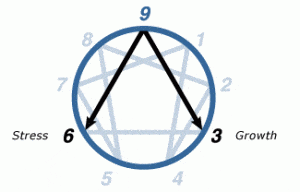
Image Credit: Enneagram Institute
Enneagram 9 in Stress: Adopting Type 6 Characteristics
-
Indicators of Stress:
- Becoming overly anxious and reactive.
- Doubting their abilities and decisions.
- Exhibiting rigidity and overcommitment in tasks to avoid conflict.
-
Scenario: In a stressful situation, Jack, a Type Nine, starts doubting every decision, becoming overly anxious about potential conflicts.
-
Practical Tip: Acknowledge the anxiety and practice grounding techniques. Focus on small, decisive actions to regain confidence in decision-making.
-
Additional Insight: Under stress, Nines may display the anxious and reactive traits of Type Six, leading to increased self-doubt and a heightened fear of conflict.
Enneagram 9 in Growth: Embracing Type 3 Qualities
-
Indicators of Growth:
- Developing self-confidence and assertiveness.
- Becoming proactive and decisive in their actions.
- Embracing their individuality and taking command of their life.
-
Scenario: As they grow, Emma, a Type Nine, starts to assert herself more, making decisions confidently and embracing her individuality.
-
Practical Tip: Encourage self-expression and assertiveness. Set personal goals and take proactive steps to achieve them.
-
Additional Insight: In growth, Nines integrate the assertive and goal-oriented qualities of Type Three, allowing them to become more self-assured and proactive in pursuing their desires.
Frequently Asked Questions (FAQs)
1. How does understanding my Enneagram type help with stress management?
Answer: Knowing your Enneagram type can provide insights into your typical stress responses and coping mechanisms. It helps you recognize patterns and offers strategies tailored to your type for managing stress more effectively.
2. Can my Enneagram type change over time?
Answer: While your core Enneagram type generally remains consistent, the way you express it can evolve. Growth and stress can bring out different aspects of your type, and life experiences can lead to a deeper understanding and expression of your type.
3. How can I identify when I’m experiencing growth or stress in my Enneagram type?
Answer: Each Enneagram type has specific indicators of stress and growth. For example, a Type Two under stress might become overly accommodating, while in growth, they may exhibit more self-care and independence. Recognizing these patterns in your behavior can help identify your current state.
4. What are some practical tips for Enneagram types to manage stress?
Answer: Stress management techniques vary by type. For instance, Type Fives might benefit from engaging more with others, while Type Eights might need to practice vulnerability. Understanding your type’s needs is key to finding effective stress management strategies.
5. How does the Enneagram address personal growth?
Answer: The Enneagram provides a roadmap for personal growth by highlighting the strengths and challenges of each type. It encourages self-awareness and offers specific paths for development, such as moving towards the positive traits of connected types.
6. Can understanding other Enneagram types help in relationships?
Answer: Absolutely. Understanding the stress and growth patterns of different Enneagram types can improve empathy and communication in relationships. It helps in appreciating others’ perspectives and responding to their needs effectively.
Conclusion: Embracing Growth and Managing Stress Through the Enneagram
Understanding your responses to stress and growth through the lens of the Enneagram can be a transformative tool in your personal development journey. By recognizing the unique ways your Enneagram type copes with challenges and thrives, you can develop healthier habits, thought patterns, and relationships.
Further Resources and Engagement:
To diver deeper into additional aspects of the Enneagram and how you can use it in your life, consider exploring these additional resources:
-
Enneagram Wings | Helpful Descriptions for Every Type: A comprehensive guide to understanding how your ‘wings’ influence your core type.
-
Enneagram Stances | How It Influences Your Interactions With Others: Learn how your Enneagram type shapes your interactions and relationships.
-
Enneagram Triads + Advice For Responding To Emotions For Each Type: Gain insights into how your type processes emotions and how to respond effectively.

